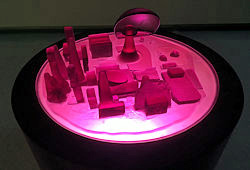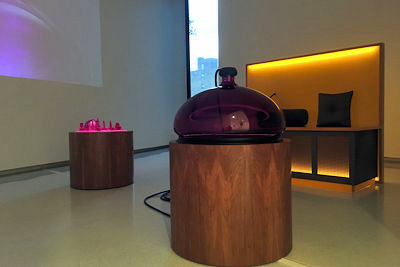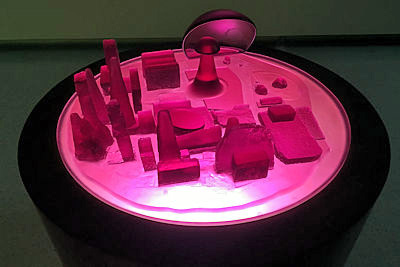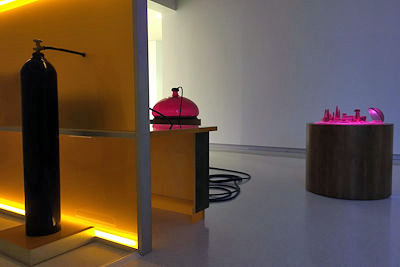
The alien Kal-El – better known as both Clark Kent and Superman – was born on the planet Krypton, then jettisoned to Earth as an infant moments before the destruction of his home world. After spending decades believing he was the lone survivor from Krypton, Superman later discovered that the supervillain Brainiac had miniaturized the capital city of Kandor and all of its inhabitants before Krypton met its unfortunate fate.
Although Superman was able to rescue Kandor from Brainiac, he was unable to free its citizens from the glass bottle in which the shrunken city had been placed. The Man of Steel instead kept Kandor safe in his Fortress of Solitude, his one-and-only link to the planet Krypton and a home world that he was unable to remember.
American artist Mike Kelley was not an avid reader of comic books, but he did know the story of Superman and the Bottle City of Kandor. After being approached by the Kunstmuseum Bonn gallery in Germany to create an exhibit for its Zeitwenden: Ausblick in 1999, Kelley spent the better part of the next ten years crafting twenty versions of the Bottle City of Kandor, basing each rendition on the drawings of a different comic book artist.
One of those Bottle Cities of Kandor – Kandor 20 – is part of the collection at the Carnegie Museum of Art in Pittsburgh, Pennsylvania. The piece was briefly on display in 2019, inside a small room that reflected the isolation of Superman’s Fortress of Solitude and the Man of Steel’s disconnection from his home world. Kandor was outside its bottle for the exhibition, while a lone bench and pillows completed the scene and the feeling of alienation that it represented.
For the Zeitwenden: Ausblick exhibit at the Kunstmuseum Bonn in 1999, Mike Kelley originally imagined a much more complex project than was actually presented, including a website that invited Superman fans to share their own thoughts and images of Kandor. The World Wide Web was still relatively new at that time, and fears were developing that the Internet would cause isolation amongst its users and eliminate real-world social interaction. As a counterbalance, Kelley also hoped that the Kunstmuseum Bonn could raise the necessary funds to bring visitors from the Kandor website to Germany for an opening reception.
“Part of my interest in having an Internet component in the installation was to stress the alienation metaphor relative to Superman’s city in a bottle, one akin to poet Sylvia Plath’s use of the bell jar as a symbol of psychic disconnection,” Mike Kelley explained in a 2010 companion book for a later Kandor exhibit. “I wanted to draw a comparison between the bell jar and the Net, presenting the Net surfer as a lonely, disembodied individual. My proposal to bring the Superman fans who met online physically together was designed to counteract this pathological reading of the Net. Kandor-Con 2000 would then truly have functioned as a real celebration and meeting place for like-minded people.”
The various elements that Mike Kelley envisioned for the Kunstmuseum Bonn exhibit – named Kandor-Con 2000 after San Diego Comic-Con – never materialized because of financial restraints. In lieu of fans on the Internet, Kelley was instead provided images of Kandor from a Superman collector in Germany. Since the image of Kandor had never been canonized within the comic books of Superman, each artist who subsequently drew the bottle city re-interpreted Kandor to fit their individual artistic styles, and Mike Kelley became fascinated by the varying depictions.
When he later revisited his original exhibit proposal, Kelley decided to take the twenty most creative designs from the comic books and bring them to life as part of a 2007 exhibit at the Jablonka Galerie in Berlin. Just like with Kandor-Con 2000, however, he encountered obstacles to his new vision right from the start. The life-size bottles he designed, for instance, were too large for conventional glass producers to create, while the idea of having particle matter floating inside to give the appearance of an atmosphere was likewise not feasible.
Mike Kelley eventually found a glass manufacturer who was able to construct the Kandor bottles in sections that were then seamed together while still molten. And although the plan to have floating matter was eventually scrapped, Kelley’s initial experimentations were videotaped and screened within the exhibit, replete with electronic sound effects that reflected the mechanical devices needed to keep the citizens of Kandor alive in their bottle.
Time restraints prevented Mike Kelley from finishing the twenty Bottle Cities of Kandor originally intended for the Jablonka Galerie exhibit in 2007 but he continued to work on them afterwards. While many of the individual Kandors are now in the possession of art galleries and collectors around the world, they have appeared together at multiple exhibits nonetheless, including the Punta Della Dogana in Venice in 2009 and Hauser & Wirth in Los Angeles in 2017 – which included one of Kelley’s final Kandor pieces, Exploded Fortress of Solitude.
“From within the depths of Superman’s fortress, the visitor is reunited with the city of Kandor, now rendered as a glowing rose-colored emanation encased beneath a bell jar,” the Hauser & Wirth website explains. “Eerily illuminating the darkness of the rocky chamber, the roseate Kandor reveals that the crevices of Superman’s solitary sanctuary actually glitter with tiny gold trinkets. The Fortress of Solitude has indeed exploded. Chaos has triumphed over order and long years of preservation have succumbed to galactic cataclysm – but we are left with a pot of gold. At the limit of loneliness and trauma, in an uncanny archaic place, we encounter a glittering symbol of duality – of hope and life, of wealth and greed.”
Mike Kelley passed away in 2012 but his reimaging of the Bottle City of Kandor remains a testament to the feeling of isolation felt by not only Superman but many human inhabitants of planet Earth as well. The differing interpretations of Kandor likewise represent the failings of memory as one grows older, causing the reflections of youth to morph into different images of remembrance in the process.
Mike Kelley’s Bottle Cities of Kandor also show that comic books are not just regulated to two-dimensional drawings but can be re-imagined as three-dimension artwork with deeper meanings than the original creator intended – enabling their fictitious worlds to be appreciated by both art fans and comic book aficionados alike.
Anthony Letizia





